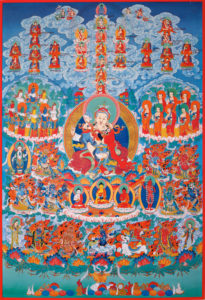Nyingma Lineage
 Katog Choling (USA) is a Buddhist practice organization affiliated with Katog Monastery in Tibet, which is one of the six main monasteries of the Nyingma school or tradition.
Katog Choling (USA) is a Buddhist practice organization affiliated with Katog Monastery in Tibet, which is one of the six main monasteries of the Nyingma school or tradition.
Meaning of Nyingma
The Nyingma lineage is considered the oldest tradition of the four schools of Tibetan Buddhism. The word Nyingma literally translates as “old” or “ancient.” “Lineage,” in this context, describes the unbroken stream of transmission from teacher to disciple within a particular school of Buddhist thought and practice, from Shakyamuni Buddha until the present day. The Nyingma lineage began with the early translations of Buddhist scriptures from Sanskrit into Tibetan in the eighth century, during the reign of King Trisong Deutsen (710–755). That is why it is referred to as the Early Translation School.
Origins in Tibet
Around 760 A.D., the dharma king Trisong Deutsen invited the powerful tantric master Padmasambhava (Guru Rinpoche), and the great scholar and abbot of Nalanda university, Shantarakshita, to the “Land of Snows” to introduce Buddhism and subjugate native deities that were obstructing its dissemination. Trisong Deutsen ordered the translation of all Buddhist scriptures from Sanskrit into Tibetan. Padmasambhava, Shantarakshita, one hundred and eight translators, and Padmasambhava’s twenty-five disciples worked for many years on this immense translation project. The translations from this period formed the basis for the large scriptural transmission of dharma teachings in Tibet known as the “Early Translation School.” Despite the various political changes over time in Tibet, these translations have been preserved and passed down in an unbroken lineage from teacher to disciple until the present day.
The other three schools of Tibetan Buddhism arose and spread later, in response to the decline of Buddhism in Tibet following the reign of the anti-Buddhist king Langdharma (836–842). These three schools (Kagyu, Sakya, and Gelug) are referred to as Sarma, which means “new” because they follow the more recent translations made from the time of the great translator Rinchen Zangpo (958–1055) onward. Since that time, the lineages have been designated either the earlier translation, Nyingma (old school), or the newer translations, Sarma (new schools).
Practice and Philosophy
The Nyingma tradition and the other three Tibetan schools of Buddhism contain all the key elements of the Buddhist path, but each has its own style of presentation. The Nyingma tradition, for example, includes the distinctive classification of the Buddhist path to liberation presented in nine vehicles (called yanas in Sanskrit) of which the Great Completeness (Dzogchen) is the ninth and highest approach. These nine vehicles encompass all teachings and practices including both the sutras and tantras, the kama and terma.
Sutras are the discourses and stories of Buddha Shakyamuni, which were later compiled and written by his principal disciples. These include extensive teachings on the entire path including conduct, the practices of loving-kindness and compassion, the view of emptiness, meditation, and the six perfections (called paramitas in Sanskrit), among others.
Tantras, also referred to as the Vajrayana or the Secret Mantra approach, are the transmissions of esoteric Buddhist practices, which include rituals and visualizations among many other profound and visionary practices. These teachings include methods to transform impure perceptions into pure perceptions, by working with body, speech, and mind as the principle means for liberation.
Kama means the words of the Buddha. In general, the term refers to the teachings given by Buddha Shakyamuni, but also to teachings from other buddhas. These have been translated from the original Indic scripture into Tibetan, then transmitted orally from master to student, up to the present day.
Termas are dharma teachings and practices that were hidden by Guru Rinpoche and Yeshe Tsogyal to be revealed at the appropriate time by ‘treasure revealers’ or tertöns. These dharma treasures were transmissions specifically directed toward benefiting future generations of practitioners.
The Nyingma tradition contains all of these traditions and approaches, and they continue to be taught and transmitted extensively today.
Masters of the lineage
The Nyingma maintains both lay and monastic traditions, with six mother monasteries: Dorje Drak and Mindroling in central Tibet, as well as Katog, Palyul, Dzogchen, and Shechen in eastern Tibet (Kham). There are too many great masters and principal figures in this tradition to enumerate here, but a few seminal figures include Longchenpa, Jigme Lingpa, Chogyur Lingpa, Patrul Rinpoche, Ju Mipham Rinpoche, and Khentrul Rinpoche’s root guru, His Holiness Jigme Phuntsok Rinpoche, among others. For more information see the Treasury of Lives website..
